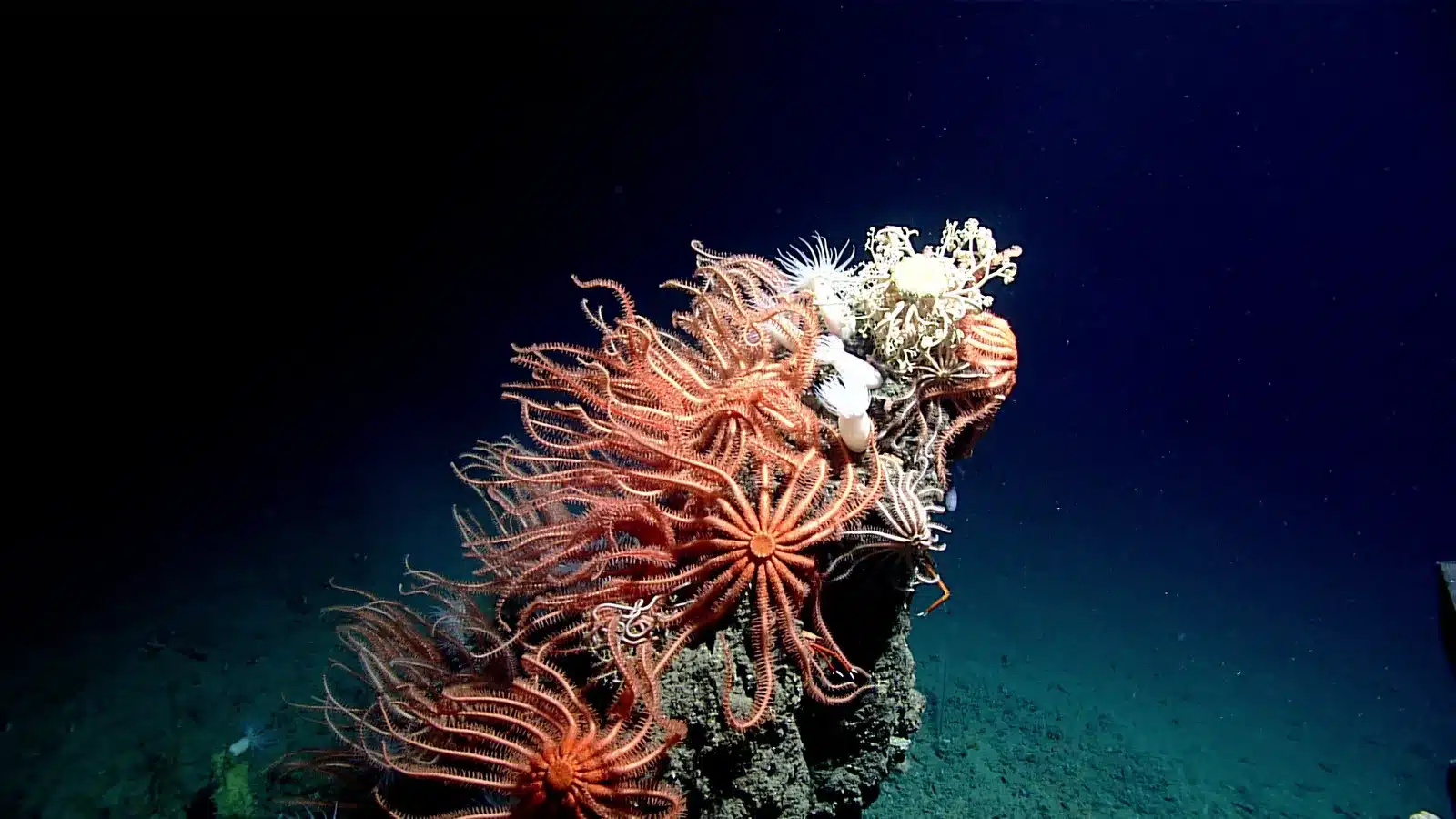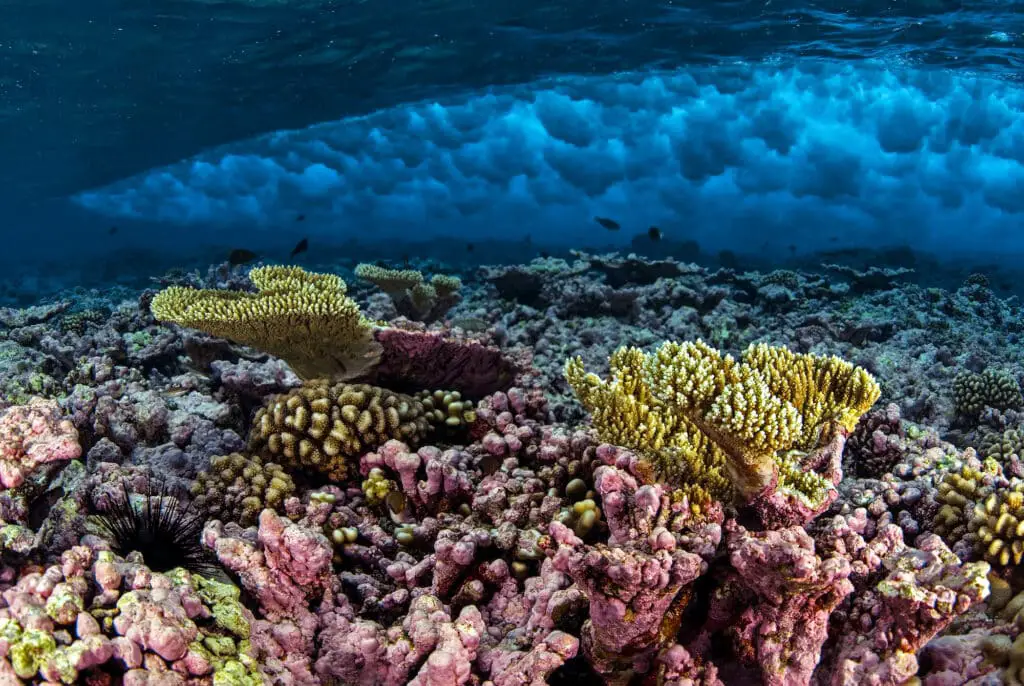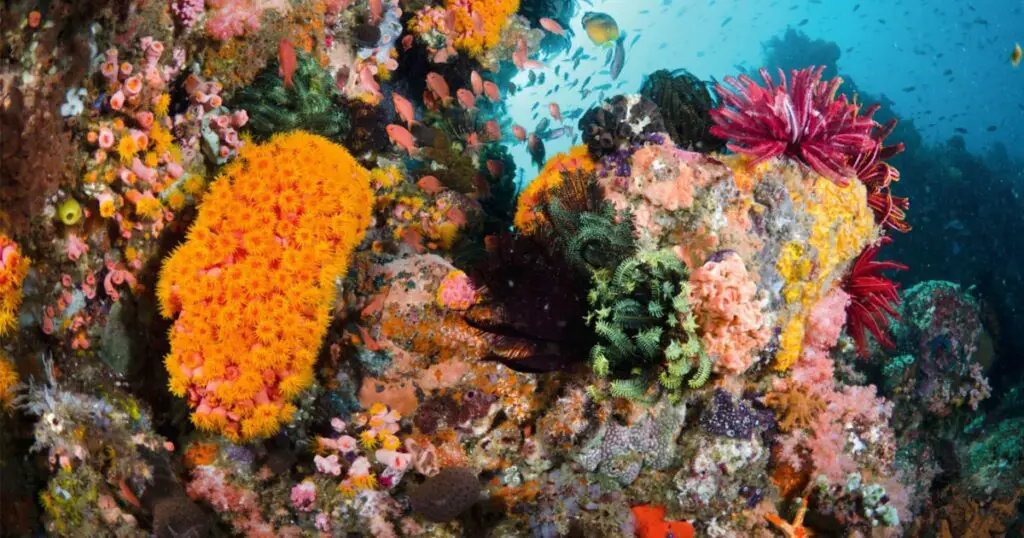What Prevents Coral Reefs From Surviving Below The Euphotic Zone

Introduction
What Prevents Coral Reefs From Surviving Below The Euphotic Zone: Coral reefs, often referred to as the “rainforests of the sea,” are among the Earth’s most diverse and ecologically vital ecosystems. They provide habitat for a plethora of marine species, support coastal communities through fisheries and tourism, and play a crucial role in carbon and nutrient cycling. However, the survival of coral reefs is under imminent threat, and one of the lesser-known challenges they face is surviving below the euphotic zone.
The euphotic zone is the upper layer of the ocean where sunlight penetrates sufficiently for photosynthesis to occur. Coral reefs predominantly thrive within this zone, where symbiotic algae called zooxanthellae provide corals with vital nutrients through photosynthesis. Yet, as we delve deeper into the ocean, light diminishes rapidly, and so does the presence of zooxanthellae.
The factors preventing coral reefs from surviving below the euphotic zone are multifaceted. As we explore this issue, we will delve into the roles of light availability, temperature, pressure, and nutrient availability in shaping the distribution and health of corals. Understanding these limitations is crucial for devising conservation strategies and safeguarding the future of these invaluable ecosystems.

What prevents coral reefs from surviving below the euphotic zone?
These organisms need sunlight and moderate temperature to survive. That’s why coral reefs, excluding deep-sea coral, can’t survive below the euphotic zone.
Coral reefs, with their stunning biodiversity and ecological significance, are predominantly found in the euphotic zone, the upper layer of the ocean where sunlight penetrates enough to support photosynthesis. However, their survival below this zone, in the deeper and darker realms of the ocean, faces several challenges.
First and foremost, corals are highly dependent on symbiotic algae known as zooxanthellae, which reside within their tissues and provide essential nutrients through photosynthesis. Beyond the euphotic zone, light levels decrease drastically, making it increasingly difficult for corals to sustain their energy needs through this process.
Additionally, temperature becomes a limiting factor as one descends deeper into the ocean. Coral reefs are adapted to specific temperature ranges, and deviations from these norms can lead to stress and coral bleaching, a phenomenon that has devastating consequences for reef health.
Why are corals restricted to the euphotic zone?
The corals’ requirement for high light also explains why most reef-building species are restricted to the euphotic zone, the region in the ocean where light penetrates to a depth of approximately 70 meters. The majority of reef-building corals are found in tropical and subtropical waters.
Corals are predominantly restricted to the euphotic zone, the upper layer of the ocean where sunlight penetrates sufficiently to support photosynthesis. This ecological limitation is primarily due to the symbiotic relationship corals have with tiny photosynthetic algae called zooxanthellae. These algae reside within the coral’s tissues and provide them with essential nutrients through photosynthesis. The availability of sunlight is crucial for this process, making the euphotic zone the ideal habitat.
Beyond the need for photosynthesis, corals also rely on warm water temperatures, which are characteristic of the upper ocean layers. The euphotic zone tends to have stable, warmer temperatures compared to the deeper, colder waters. Corals are ectothermic organisms, meaning they rely on the surrounding environment to regulate their body temperature. This further reinforces their preference for the shallower, sunlit regions of the ocean.
The intricate relationship between corals and their symbiotic algae, coupled with their dependence on sunlight, warm temperatures, and protection from predators, collectively restrict these vital marine organisms to the euphotic zone of the ocean. This ecological niche ensures corals thrive in environments where they can effectively carry out their life processes and contribute significantly to marine ecosystems.
Why coral reefs are currently struggling to survive?
Increased ocean temperatures and changing ocean chemistry are the greatest global threats to coral reef ecosystems. These threats are caused by warmer atmospheric temperatures and increasing levels of carbon dioxide in seawater. As atmospheric temperatures rise, so do seawater temperatures.
Coral reefs are currently facing a perilous struggle for survival due to a confluence of anthropogenic and natural stressors. Chief among these is climate change, which has led to rising sea temperatures and ocean acidification. Elevated temperatures cause a phenomenon known as coral bleaching, where corals expel their essential symbiotic algae, leading to their eventual death if conditions do not improve.
Human activities also exacerbate the crisis. Overfishing disrupts the delicate balance within coral reef ecosystems, leading to an overabundance of algae that can smother and outcompete corals. Pollution, including agricultural runoff and plastic waste, further degrades water quality, making it harder for corals to thrive. Physical damage from activities such as anchoring, coastal development, and tourism exacerbate the challenges corals face.
Destructive practices like dynamite fishing and coral mining directly harm reefs. Inadequate protection and management of these delicate ecosystems also contribute to their decline. The cumulative impact of these stressors presents a grave threat to coral reefs worldwide, underscoring the urgent need for concerted global efforts to mitigate these pressures and ensure the long-term survival of these invaluable marine ecosystems.
How can we protect the coral reef?
Every Day
- Recycle and dispose of trash properly. Marine debris can be harmful to coral reefs.
- Minimize use of fertilizers.
- Use environmentally-friendly modes of transportation.
- Reduce stormwater runoff.
- Save energy at home and at work.
- Be conscious when buying aquarium fish.
- Spread the word!
Protecting corals in areas prone to bleaching requires a multifaceted approach that addresses both global and local stressors. Firstly, immediate action must be taken to mitigate climate change. This involves reducing greenhouse gas emissions through measures like transitioning to renewable energy sources and implementing sustainable land-use practices.
On a local level, creating marine protected areas (MPAs) and enforcing strict regulations within them is crucial. MPAs act as sanctuaries where corals can recover without the added pressures of overfishing and destructive human activities. Implementing sustainable fishing practices outside of these areas helps maintain a balanced ecosystem, preventing the overgrowth of algae that can smother corals.
Education and awareness campaigns are vital in engaging local communities and fostering a sense of stewardship for these delicate ecosystems. By combining global climate action with targeted local conservation efforts, we can enhance the resilience of corals in areas prone to bleaching, ensuring their continued existence for generations to come.
Why is the euphotic zone so important to ocean life?
Algae and vascular plants that live in the water must live close enough to the surface to receive sunlight. The euphotic zone is the layer of water in which there is enough light for net photosynthesis. In other words, the rate of photosynthesis is faster than the rate of respiration (Fig. 2.42).
This upper layer of the ocean extends from the surface to a certain depth, typically about 200 meters (656 feet), although this depth can vary depending on water clarity and geographic location. Several key factors highlight the significance of the euphotic zone for ocean life.
- Photosynthesis: The primary reason the euphotic zone is crucial is because it is the zone where sunlight penetrates sufficiently for photosynthesis to occur.
- Biodiversity: The euphotic zone’s abundance of light and nutrients supports a wide variety of marine species. From microscopic phytoplankton to larger fish and marine mammals, many organisms rely on the productivity of this zone for their survival.
- Energy Transfer: It serves as an energy transfer point in the ocean, as the organic matter generated through photosynthesis in the euphotic zone becomes food for other organisms. This energy transfer sustains complex food webs and ecosystems, ultimately impacting the health and abundance of marine species throughout the ocean.
- Carbon Cycle: The euphotic zone plays a crucial role in the global carbon cycle. Phytoplankton in this zone absorb substantial amounts of carbon dioxide, helping regulate atmospheric carbon levels and mitigate climate change.
In essence, the euphotic zone is the lifeblood of the ocean, supporting the growth of marine organisms, maintaining biodiversity, driving essential ecological processes, and contributing to the overall health and balance of our planet’s marine ecosystems. Understanding and preserving this zone is fundamental to the well-being of ocean life and, by extension, life on Earth.
Are there any exceptions to coral survival below the euphotic zone?
There are exceptions to coral survival below the euphotic zone, although they are relatively rare and occur under specific circumstances. Certain species of corals, known as deep-sea or cold-water corals, have adapted to thrive in deeper, darker waters where sunlight is minimal or absent. These corals are found in depths ranging from a few meters to thousands of meters below the ocean’s surface.
Deep-sea corals do not rely on photosynthetic algae for their primary source of nutrition. Instead, they have developed alternative feeding mechanisms, such as capturing small planktonic organisms that drift by in ocean currents. Additionally, these corals tend to have slower growth rates compared to their shallow-water counterparts.
These deep-sea coral communities are often associated with specific geological features like seamounts, underwater ridges, and continental slopes. They provide crucial habitat for a diverse range of marine life, including various species of fish and invertebrates.
While deep-sea corals have evolved to thrive in the absence of sunlight, they are still susceptible to their own unique set of stressors, including changes in water temperature, ocean acidification, and physical disturbance from activities like deep-sea trawling. Protecting these remarkable ecosystems remains a critical component of global marine conservation efforts.
How can we protect coral reefs within the euphotic zone?
Protecting coral reefs within the euphotic zone requires a combination of global and local strategies. To address climate change, we must advocate for and implement policies that reduce greenhouse gas emissions. Transitioning to renewable energy sources, promoting energy efficiency, and supporting carbon capture initiatives are crucial steps in mitigating rising sea temperatures and ocean acidification.
At the local level, establishing and effectively managing marine protected areas (MPAs) is paramount. These designated zones serve as refuges where corals can recover from stressors like overfishing and physical damage. Strict enforcement of regulations within MPAs is essential to their success.
Sustainable fishing practices should be promoted outside of protected areas to maintain a balanced ecosystem. This prevents overgrowth of algae, which can smother corals. Additionally, reducing pollution through proper waste management, regulating industrial discharge, and educating communities about responsible practices is vital for water quality.
Coastal development should be carefully planned to minimize impact on adjacent reefs. Implementing measures like mooring buoys, which allow boats to anchor without damaging the reef, safeguards against physical harm.
Tourism operators can play a significant role by promoting responsible practices among visitors, such as avoiding contact with corals and using reef-friendly sunscreens.
Ultimately, fostering education and awareness within local communities is key to building a culture of conservation and ensuring the long-term survival of these invaluable marine ecosystems.
What are the threats to coral reefs in the euphotic zone?
Coral reefs in the euphotic zone, while vital to marine biodiversity, face an array of threats. Chief among them is climate change-induced coral bleaching. Rising sea temperatures cause corals to expel their symbiotic algae, leading to their bleached appearance and weakened state. Prolonged or severe bleaching events can result in coral mortality, disrupting the entire ecosystem.
Ocean acidification, driven by the absorption of excess carbon dioxide, hinders corals’ ability to build and maintain their calcium carbonate skeletons. This weakens their structural integrity and leaves them more susceptible to damage from storms and physical disturbances.
Overfishing and destructive fishing practices contribute to the degradation of reefs. Removing key herbivores disrupts the delicate balance between corals and algae, leading to overgrowth of algae that can smother and outcompete corals for space and light.
Physical damage from activities like anchoring, coastal development, and tourism can directly harm reefs. Improperly anchored boats, for instance, can cause significant localized destruction.
Addressing these threats requires concerted global efforts to combat climate change, along with local measures such as marine protected areas, sustainable fishing practices, and strict regulations on coastal development and tourism activities.

Conclusion
In the depths below the euphotic zone, coral reefs face a multitude of challenges that threaten their survival. While these mesmerizing ecosystems predominantly thrive in sunlit waters, the journey into the shadowy depths reveals a story of adaptation, resilience, and vulnerability.
Light availability stands as the primary impediment to coral health beyond the euphotic zone. Corals, dependent on symbiotic zooxanthellae for sustenance, struggle to harness sunlight’s energy in these dimly lit waters.
As we strive to protect and conserve coral reefs, it is essential to recognize the critical role of the euphotic zone as the cradle of their existence. Efforts to mitigate climate change, reduce pollution, and establish marine protected areas can contribute to the preservation of this vital zone and, consequently, the survival of coral reefs. Research into coral adaptations to low-light environments and their genetic diversity may also hold keys to enhancing their resilience.
The challenges coral reefs encounter below the euphotic zone are a poignant reminder of the fragile balance within these underwater marvels. By addressing the factors that prevent their survival in these depths, we can better equip ourselves to safeguard these invaluable ecosystems and the myriad species that depend on them for their existence.



